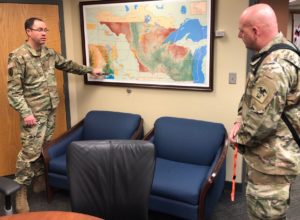Brian Hill
FORT LEONARD WOOD, Mo. (April 15, 2020) — As the COVID-19 response continues, Fort Leonard Wood’s U.S. Army Engineer School has sent engineers to locations across the country to assist the U.S. Army Corps of Engineers with the planning and building of alternate care facilities that will expand the number of hospital beds available for treating patients.
According to Maj. Rich Ghinelli, officer in charge of the USAES augmentation mission, the officers and warrant officers on this mission have advanced degrees and certifications, and will primarily use their skills in site assessment, mission tracking and data management, as well as acting in quality assurance roles, overseeing contractors as ACFs are constructed.
“The U.S. Army engineer officer has a variety of skills that are pertinent to this support mission,” Ghinelli said. “The selected engineer officers all have training and experience in running a tactical operations center that conducts operations planning and tracking to accurately report the progress of the mission and recommend needed adjustments. Other officers will directly support USACE teams conducting site assessments of potential ACF locations and provide quality control and assurance of contracted construction to ensure the plan comes together as rapidly and correctly as possible to provide critical facilities to those in need.”
Additionally, Ghinelli said geospatial engineer officers are supporting the mission by visually tracking resource distribution and mapping project status and pandemic statistics to provide leaders with a common operating picture.
“These maps enable district leaders to visualize current and projected hospital-bed occupancy rates, which help the district commander and local leaders better understand COVID-19 saturation and severity,” Ghinelli added.
Lt. Gen. Todd Semonite, U.S. Army Corps of Engineers commander, said USACE has built 17 facilities so far with a total of nearly 15,000 beds.
In the next several months, Semonite estimated 40 to 50 total facilities might be built by USACE, dependent on the number of COVID-19 cases.
Ghinelli said the scale of the emergency response required for this mission is one of the biggest reasons for Fort Leonard Wood’s engineers to be supporting USACE.
“The majority of (USACE) is comprised of civilian employees who are not typically deployed or working from an operations center,” Ghinelli said. “So, as the size and scope of their operations increased to the level … required for the COVID-19 pandemic, Soldiers from the U.S. Army Engineer School and Engineer Regiment are uniquely suited to augment USACE and expand their already significant disaster response capability.”
Ghinelli added that in recent years, USAES has supported three other large-scale emergency response situations: Hurricane Katrina in 2005, Super Storm Sandy in 2012 and hurricanes Harvey, Irma and Maria in 2017.
“In every case these officers played a significant role in executing the National Response Plan,” Ghinelli said.
Brig. Gen. Mark Quander, U.S. Army Engineer School commandant, spoke to Fort Leonard Wood’s engineers before they departed April 6. He told them he was proud of everything they were about to do.
“We’re asking you to use all the talents that you have learned in the military to date and contribute to our nation’s efforts to win the war against COVID-19,” he said. “When we’ve recovered as a nation, you will each look back and reflect on the contributions you made to help overcome the adversities that we all endured through this significant point in our nation’s history — and you will have made a difference.”


-30-
About Fort Leonard Wood
Fort Leonard Wood is a thriving and prosperous installation that has evolved from a small basic training post more than 75 years ago to a premier Army Center of Excellence that trains more than 80,000 military and civilians each year.
Fort Leonard Wood is home to the U.S Army Maneuver Support Center of Excellence and three U.S. Army schools: the U.S. Army Engineer School; U.S. Army Chemical, Biological, Radiological and Nuclear School; and the U.S. Army Military Police School. In addition to training engineer, CBRN and military police specialties for the Army, Fort Leonard Wood also provides gender-integrated in-processing and Basic Combat Training for new Soldiers.
Fort Leonard Wood also hosts and trains with the largest Marine Corps Detachment and Air Force Squadron on any Army installation as well as a large Navy construction detachment.
More information about Fort Leonard Wood is at: https://home.army.mil/wood/index.php/about/mission
